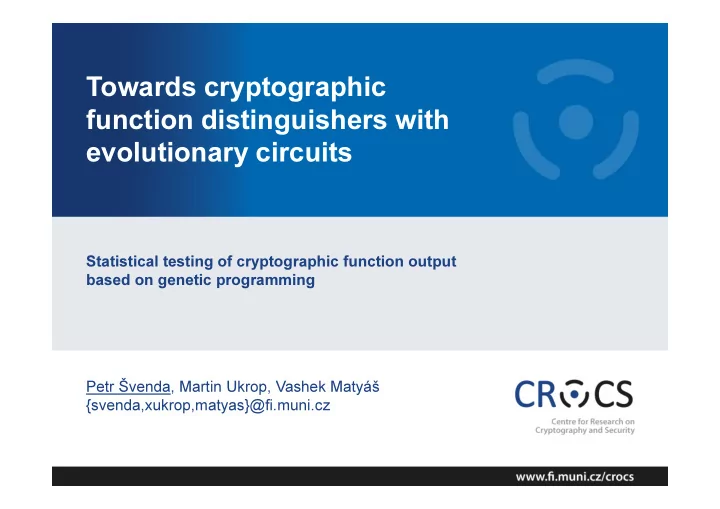

Towards cryptographic function distinguishers with evolutionary circuits Statistical testing of cryptographic function output based on genetic programming Petr Švenda, Martin Ukrop, Vashek Matyáš {svenda,xukrop,matyas}@fi.muni.cz
Overview 1. Randomness testing with STS NIST & Dieharder – Can we beat traditional approach? (Speed, input length.) 2. Random distinguisher based on software circuit – Our approach based on genetic programming 3. Results for selected eStream/SHA-3 candidates – How good is it? 4. Discussion, interesting observations 2 | SeCrypt 2013, Reykjavík, 30.7.2013
Why to test randomness of function output? 1. Building block for pseudorandom generator 2. Common requirement – AES, SHA-3 competition, FIPS-140 3. Significant deviances from uniform distribution and unpredictability indicate function defects – but no proof in opposite case • Manual approach: human cryptanalysis • Automated approach: statistical testing 3 | SeCrypt 2013, Reykjavík, 30.7.2013
Workflow with STS NIST/Dieharder Tests Count the 1s Overlapping permutations 1001110011...100 1001110011...100 Runs tests 1001110011...100 .... 1001110011...100 1001110011...100 1001110011...100 1001110011...100 “null hypothesis” 10 5 -10 9 B ⇒ p-values p-value < α ⇒ fail 4 | SeCrypt 2013, Reykjavík, 30.7.2013
Test vectors 1011010100...101 1001110011...100 500x 500x 1011010100...101 Algorithm execution Hypothesis: If function output is somehow defective, we should be able to distinguish between the data produced by a function and truly random data. Results 1/0 1 => QRNG 5 | SeCrypt 2013, Reykjavík, 30.7.2013
Proposed idea – software circuit • Design test(s) automatically – test is algorithm ⇒ hardware-like circuit (next slide) • Several issues: – Who will define null hypothesis? (random distinguisher) – Who will design the circuit? (genetic programming) – How to compare quality of candidates? (test vectors) 6 | SeCrypt 2013, Reykjavík, 30.7.2013
https://github.com/petrs/EACirc/ Software circuit (EACirc) Input layer Internal layers Output layer Outputs 7 | SeCrypt 2013, Reykjavík, 30.7.2013
Genetic programming of circuits Test vectors (10 2 -10 5 ) [input i ] [exp.output i ] Population fitness % correct answers Comparator exp.output i == output Circuit emulator 8 | SeCrypt 2013, Reykjavík, 30.7.2013
Test vectors 1011010100...101 1001110011...100 500x 500x 1011010100...101 Circuit execution Fitness 10110111 HW(10110111) > 4 => QRNG 9 | SeCrypt 2013, Reykjavík, 30.7.2013
Methodology • Limit number of algorithm rounds – tested on 7 eStream and 18 SHA-3 candidates • Generate & run STS NIST and Dieharder tests • Prepare input data for EACirc – generate ½ test vectors from function (key change freq.) – generate ½ test vectors from truly random source (QRBGS http://random.irb.hr/) • Generate & test software circuits (repeat, EA) 10 | SeCrypt 2013, Reykjavík, 30.7.2013
Were we successful? • Definition of success? • Better than random guessing? • Better or at least as good as human-made batteries? • Other advantages against statistical batteries? 11 | SeCrypt 2013, Reykjavík, 30.7.2013
Salsa20 – limited to two rounds (0.87 success rate) 12 | SeCrypt 2013, Reykjavík, 30.7.2013
Test vectors – key change frequency Key fixed for whole run (all generations) 100111101001110100...01010101010010100011100 Key fixed only for one test set (e.g., 500 test vectors) 10011...1100 10011...1100 10011...1100 Key per every test vector (e.g., every 16 bytes) 100...10 110...11 101...00 100...10 110...11 101...00 13 | SeCrypt 2013, Reykjavík, 30.7.2013
14 | SeCrypt 2013, Reykjavík, 30.7.2013
Decim – 6 out of 8 rounds (preliminary) test vector change (drop in success) χ 2 difference between random/fnc histograms of categories 15 | SeCrypt 2013, Reykjavík, 30.7.2013
What is a function test then? • One particular circuit? – circuit was evolved for particular function and key – sometimes, circuit works even when key is changed – (most probably) not useful for a different function • Test = whole process with evolution of circuits! – Is evolution able to design a distinguisher in limited number of generations? – If so, then function output is defective! 16 | SeCrypt 2013, Reykjavík, 30.7.2013
Comparison to statistical batteries • Advantages – new approach, no need for predefined pattern – dynamic construction of test for particular function – works on very short sequences (16 bytes only) • Disadvantages – no proof of test quality or coverage (random search) – possibly hard to analyze the result (possibly automatic) – possibly longer test run time (learning period) Questions 17 | SeCrypt 2013, Reykjavík, 30.7.2013
Thank you for your attention! Questions 18 | SeCrypt 2013, Reykjavík, 30.7.2013
19 | SeCrypt 2013, Reykjavík, 30.7.2013
Recommend
More recommend